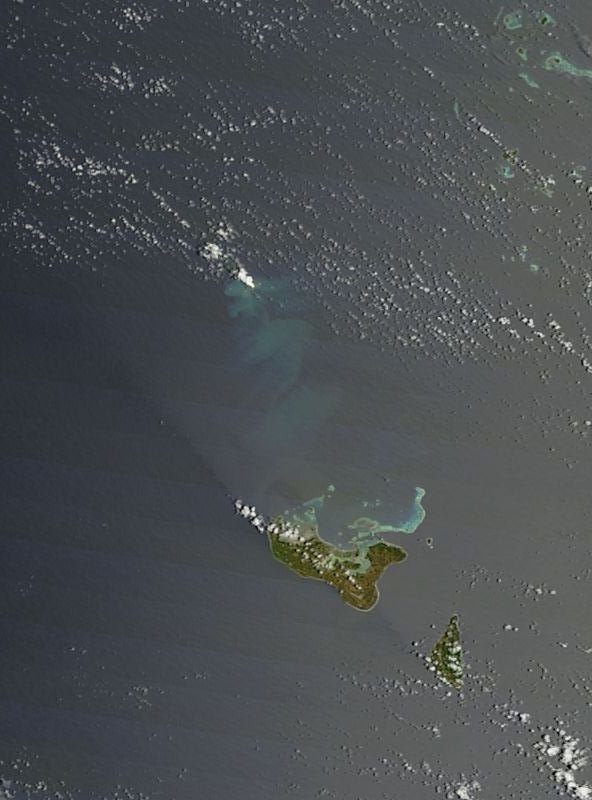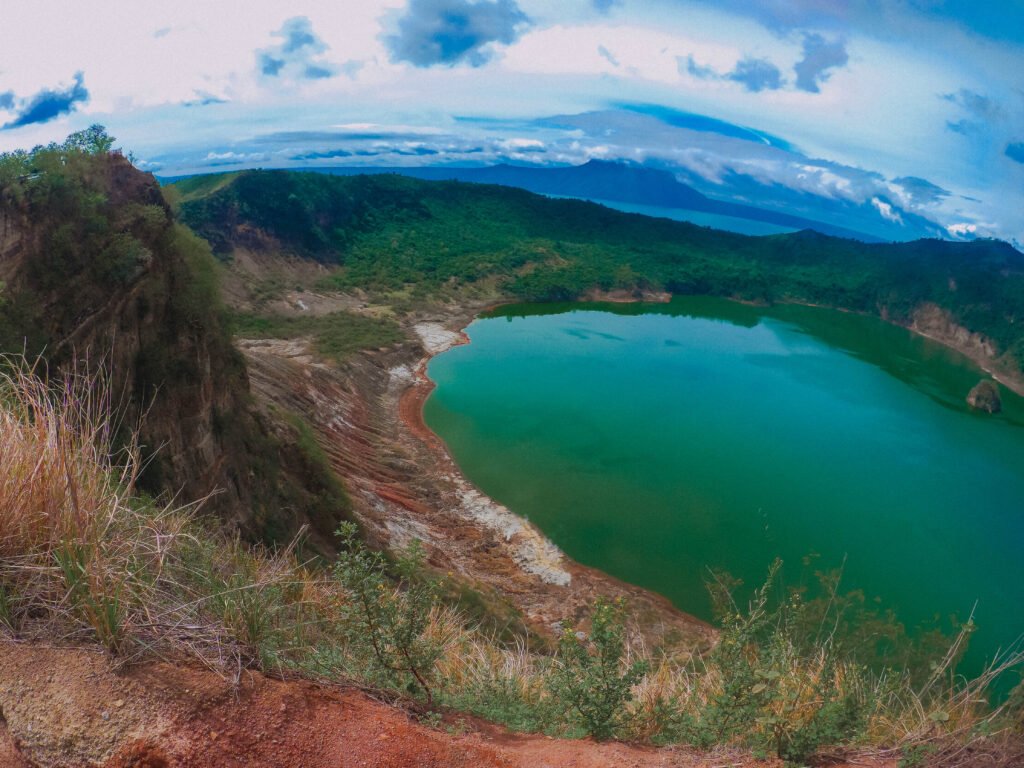Imagine waking up on a remote tropical island, surrounded by turquoise waters, lush greenery, and black sand beaches. Now, picture this: the very ground beneath your feet was once nothing but a restless patch of ocean, its surface undisturbed by land. What could possibly transform a watery abyss into a chain of islands teeming with life? The answer is both awe-inspiring and explosive—underwater volcanoes. Few forces on Earth can rival their power or their creativity, as they build entire worlds from fire and water. Let’s dive deep—literally—into the breathtaking story of how a volcano in the ocean can give birth to an entire island chain.
The Fiery Heart Beneath the Waves

Beneath the calm surface of the ocean lies a world in constant motion. Tectonic plates, those gigantic slabs of Earth’s crust, slowly drift and grind against one another. When they part ways or collide, molten rock from deep within the planet surges upward. This magma, hotter than any oven and under immense pressure, often finds its escape through cracks in the ocean floor. Like a hidden heart pumping with energy, these underwater volcanoes are always at work, shaping the seafloor in ways we rarely see but often feel.
Magma Meets Water: The Birth of a Seamount

As magma bursts through the ocean floor, it cools rapidly upon contact with the chilly seawater. This sudden cooling transforms the molten rock into solid stone, slowly piling up layer by layer. Over thousands, sometimes millions, of years, these layers grow taller, forming immense underwater mountains called seamounts. Most never breach the surface, but some keep building until they finally break through, hinting at a new land above the waves.
The Making of an Island: From Seamount to Summit

When a seamount grows tall enough to rise above the ocean surface, it becomes an island. This is not a quiet arrival; steam hisses, rocks explode, and the sea churns as the newborn island fights its way into the light. At first, the island may seem barren, a harsh landscape of black lava and jagged stone. But this is only the beginning—over time, wind, rain, and waves begin to shape the land, smoothing sharp edges and carving out beaches.
The Role of Hotspots: Nature’s Underwater Furnaces

Some volcanoes don’t follow the edges of tectonic plates. Instead, they form over “hotspots”—fixed plumes of superheated rock that rise from deep inside the Earth. As a tectonic plate moves over a hotspot, magma punches through the crust, creating volcano after volcano in a line. The Hawaiian Islands are the world’s most famous example of this process. The islands trace the path of the Pacific Plate as it slowly slides over a relentless, fiery jet of molten rock.
One Volcano, Many Islands: The Chain Effect

With each passing millennium, the tectonic plate keeps moving, but the hotspot stays put. The original volcano drifts away from the magma source and becomes dormant, while a new volcano forms on the fresh part of the plate above the hotspot. This leapfrog effect creates a chain of islands, each one younger and more volcanically active than the last as you move toward the hotspot. This is how an entire archipelago can rise from the depths, born from a single, persistent source of magma.
Erosion and Evolution: Shaping the New Lands

Once above water, the young islands face the relentless forces of erosion. Rain carves valleys, waves chip away at the shoreline, and winds scatter seeds from distant lands. Over millions of years, the raw volcanic rock slowly transforms into fertile soil. Rivers may form, waterfalls cascade down cliffs, and beaches of all colors—white, black, even green—appear along the coasts. The islands take on new shapes, some developing dramatic cliffs while others wear away into gentle slopes.
Colonization by Life: From Barren Rock to Paradise

At first, the new islands are completely lifeless. But nature is persistent and resourceful. Birds, wind, and ocean currents carry seeds, insects, and even small animals across vast distances. The first plants—often hardy ferns and mosses—begin to take hold in cracks and crevices. Over time, lush forests and vibrant ecosystems spring to life, turning the once-sterile lava fields into thriving habitats for countless species.
Unique Ecosystems: Evolution in Isolation

Island chains formed by volcanoes become natural laboratories for evolution. Isolated from the mainland, plants and animals adapt in surprising and sometimes bizarre ways. On the Galápagos Islands, for example, volcanic origins gave rise to unique species like giant tortoises and Darwin’s famous finches. Each island’s different conditions—climate, altitude, soil—push species to evolve separately, creating a living tapestry of diversity found nowhere else on Earth.
Volcanic Activity: Destruction and Renewal

Even after islands have formed, volcanic eruptions continue to shape their destiny. Lava flows may destroy forests, bury beaches, and reshape coastlines overnight. Yet this destruction is often followed by renewal, as fresh minerals from the lava make the soil even richer. Some species, like certain types of ferns or pioneer trees, thrive on these newly cooled rocks, quickly reclaiming the land after an eruption.
Submarine Eruptions: Hidden Power Unleashed

Most volcanic activity in the ocean goes unseen, far below the surface where sunlight never reaches. Submarine eruptions can be enormous and violent, sending clouds of ash and gas thousands of feet upward. Occasionally, these eruptions are so powerful that they temporarily create new islands, only to have them vanish beneath the waves once more. These fleeting events remind us that the ocean’s surface hides a world in constant upheaval.
Calderas and Craters: The Aftermath of Explosion

Some volcanic eruptions are so massive that they collapse the summit of the volcano itself, creating a giant depression known as a caldera. These calderas can fill with water, becoming crater lakes, or serve as the starting point for new volcanic activity. The story of an island chain is often one of constant creation and destruction, with each dramatic event leaving a unique mark on the landscape.
Atolls: Coral’s Final Embrace

When a volcanic island begins to sink back beneath the waves—a process called subsidence—something remarkable happens. Coral reefs, which have been quietly growing around the island’s shores, keep building upward. Eventually, the island disappears, leaving behind a ring-shaped coral reef called an atoll. These atolls are among the most beautiful and fragile places on Earth, their turquoise lagoons a final tribute to the vanished volcano that started it all.
Volcanic Soil: The Secret to Lush Life

Islands born from volcanoes often become some of the most fertile places on the planet. The reason? Volcanic ash and lava are packed with minerals like potassium and phosphorus that plants crave. Over time, as the rock weathers and breaks down, it creates rich, dark soils. This is why places like Hawaii and Iceland can support such lush rainforests and productive farms, despite their rocky beginnings.
Human Settlement: Living with Fire

People have always been drawn to volcanic islands, despite—or perhaps because of—their danger and unpredictability. The rich soils, abundant fish, and natural beauty make these islands ideal for human settlement. But living in the shadow of a volcano is not without risk. Eruptions can force entire communities to flee, and tsunamis triggered by volcanic activity can devastate coastal towns in minutes. Yet, for many, the rewards outweigh the risks.
Culture and Myth: Volcanoes in the Human Imagination

Volcanoes are not just geological features—they are woven into the stories, myths, and spiritual beliefs of the people who live near them. In Hawaii, Pele is revered as the goddess of fire, creator of the islands themselves. Across the Pacific, legends tell of gods and spirits who shape mountains and control eruptions. These stories reflect a deep respect for the power and unpredictability of volcanic forces.
Modern Science: Watching the Giants

Today, scientists use satellites, underwater robots, and seismic sensors to monitor volcanic activity across the world’s oceans. These tools help us predict eruptions, warn nearby communities, and better understand the processes that shape our planet. Despite these advances, much of the volcanic world remains mysterious, lurking in the deep ocean beyond our reach.
Island Chains Around the Globe

The process of volcanic island formation isn’t unique to one part of the world. The Pacific Ring of Fire is dotted with island chains born from underwater eruptions, like the Aleutians, the Marianas, and Tonga. The Atlantic and Indian Oceans host their own volcanic islands, each with its own history and unique blend of life. Together, these islands form stepping stones across the world’s waters, connecting continents and cultures.
Climate and Weather: Volcanoes as World Shapers

Volcanic eruptions can influence climate far beyond their own islands. Massive explosions can send ash and gases high into the atmosphere, blocking sunlight and cooling the planet for years at a time. Ancient eruptions have been linked to famines, disrupted weather patterns, and even the fall of empires. Yet, in smaller ways, volcanic islands create their own weather systems, with clouds, rain, and winds shaped by their unique landscapes.
Tourism and Conservation: A Delicate Balance

Volcanic islands attract millions of tourists each year, drawn by their dramatic scenery, unique wildlife, and vibrant cultures. But this popularity comes at a price. Fragile ecosystems can be damaged by careless visitors, and the pressure to develop resorts threatens the delicate balance of nature. Conservationists work tirelessly to protect these special places, ensuring that future generations can marvel at their beauty and wonder.
The Endless Cycle: Creation, Destruction, and Renewal

The story of volcanic island chains is as old as the Earth itself—a never-ending cycle of birth, death, and transformation. Every island, from the newest black-rock outcrop to the oldest, coral-crowned atoll, is a testament to the incredible power of nature to create and recreate our world. The next time you walk along a sun-warmed beach or gaze up at a volcanic summit, remember: you’re standing on a miracle forged by fire and shaped by time.




